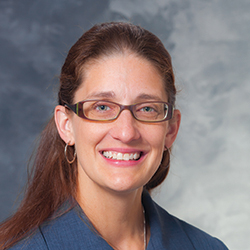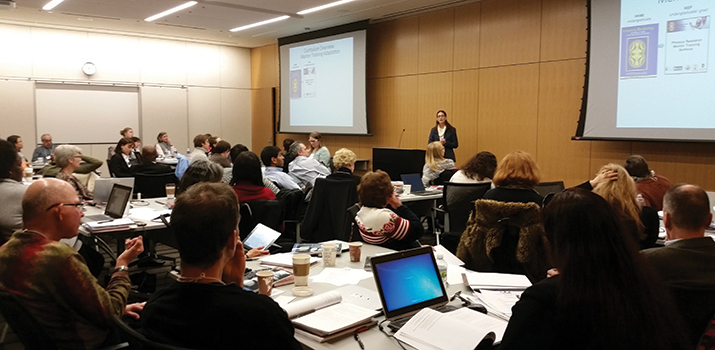Enabling effective mentorship
What makes mentorship successful? That’s what Christine Pfund studies at the University of Wisconsin–Madison. Pfund is interested in understanding, developing and implementing effective mentor training in science, engineering and medicine.
 Christine PfundPHOTOS PROVIDED BY PFUND
Christine PfundPHOTOS PROVIDED BY PFUND
“We’re putting our precious trainees in the hands of folks who are well-intentioned but have had no professional development in the arena (of mentoring). It leaves a lot to chance,” she says. “No matter how well-intended someone is and no matter how good they are, there is always room” to improve.
After earning a Ph.D. in cell and molecular biology, Pfund did a postdoctoral stint in the early 2000s in the department of plant pathology. She then switched her focus to improving classroom teaching and research mentoring.
These days, Pfund is one of the principal investigators of the National Research Mentoring Network that was established recently by the National Institutes of Health. She is also director of the new Center for the Improvement of Mentored Experience in Research.
Rajendrani Mukhopadhyay, the chief science correspondent for the American Society for Biochemistry and Molecular Biology, spoke with Pfund to find out more about her research in effective mentoring practices. The interview has been edited for length and clarity.
How did you become interested in mentoring?
I’d always been interested in improving teaching in the classroom and had been doing a lot of work on the side at UW Madison. About halfway through my postdoc, I started to think about what I really could do in that arena. (At the same time,) UW Madison got two big grants. One was a (National Science Foundation) grant to Robert Mathieu to establish a Center for the Integration of Research, Teaching and Learning, CIRTL, and the other was the (Howard Hughes Medical Institution) professor grant to Jo Handelsman.
I spent the next eight years working for both programs. I was an associate director of the CIRTL program at UW Madison, working primarily on professional development for future faculty in STEM. I was also a co-director of the Wisconsin Program for Scientific Teaching, which came out of Jo Handelsman’s HHMI grant. (Author’s note: Handelsman currently is the associate director for science at the White House Office of Science and Technology Policy.) The program was on improving teaching in biological sciences, faculty professional development and establishing national summer institutes. A part of that project also was to develop research mentor training.
The research mentor and mentee training continued to grow. We were able to take successes from the original HHMI grant and work with CIRTL and get an NSF grant. Then I moved over to the medical school and started working on adaptations of our approaches for clinical and translational research. I started to get some research grants and worked with social scientists and others to study interventions and start to understand mentoring relationships.
Most recently, I used all of that to become part of the leadership for the National Research Mentoring Network. It allows us to continue the work to understand interventions on a much more national scale and scale up training from evidence-based approaches.
How do you define mentoring?
The across-the-board generic definition of mentoring focuses on it being a collaborative learning relationship that proceeds through purposeful stages over time and has the primary goal of helping the mentees gain the skills and knowledge they need to move on in their chosen careers. That applies to many different kinds of mentoring relationships. It could be a classic research mentoring relationship like we know in the sciences. It can have elements of career coaching. It could be peer mentoring. It could be virtual mentoring with someone who doesn’t even have a research relationship with you.
Are there differences in mentoring between science and other fields?
When we did our adaptation work for some of our mentor–training interventions, we expected, across the STEM disciplines, for things to be very similar. What we found out was that the differences that were most salient were not between, for example, chemistry, physics and math. The differences were in projects. The kind that were theoretically based, where there was a lot of thinking, had a different nature (of mentoring) because you were working together on an idea. It was different than the “we’re doing something hands-on together.” We found the nature of the work had implications on the relationship.
Imagine when you’re in a meeting (with a mentee). You’re saying, “You need to have your own idea, and I’ll bounce off whether it’s a good theoretical idea.” Even the nature of those conversations is different from “Here, you need to master these skills, come up with an idea and implement it.”
The nature of the work influences the nature of the conversation that happens between mentor and mentee.
How do you make sure you’re not creating “mini-mes” (clones of professors) and are paying attention to diversity?
There needs to be, both at the individual mentor–mentee level as well as at a systems level, the recognition to address diversity within these relationships and acknowledge that culture plays a role. How people work, what they think is important, the motivation to do it, the vision they have for what is possible and why it matters — those are all culturally informed. If we don’t pay attention to those things within mentoring relationships, research programs and training programs, it’s going to continue to privilege the dominant cultural norms. There will not be an acceptance and a benefit from embracing different value orientations (as well as) an allowance for diversification of the workforce.
Diversification of the workforce isn’t just about embracing people who have different backgrounds. It’s about embracing that they bring different values and orientations to the table. That happens at the individual level and at the organizational level. Mentoring is the place where this needs to be addressed. If individual mentors believe that their role is to create “mini-me’s,” then who they accept, how they train, what they see as success and what ideas they accept become enormously limited.
How do you get mentors to think about what they are doing?
Mentors need to reflect on what is their motivation for taking on mentees. If their motivation for doing it is so that people can be just like them, then that has a huge influence on who they should be taking. If their idea is to inspire the next generation to do amazing things, then they need to really think about if they have set up the relationship and the environment to empower those successes.
We are putting forth this idea of culturally responsive mentoring. Cultural context matters. We are creating training to get mentors to start to work through their own assumptions — not just their biases but their own assumptions about the role that culture plays, how they can create space for that and acknowledge the impact it has. If we continue to force folks to check their culture at the door when they enter the lab, then we also choose to check all the benefits that come with it at the door.
 Pfund says people need to reflect on their motivations to mentor.
Pfund says people need to reflect on their motivations to mentor.
Do you think mentorship in science has changed over time?
It may feel like there’s not been a lot of change, but there has been. The conversation alone has changed. The fact that federal agencies are calling for evidence-based mentoring to be part of the training programs — it’s a huge change. While it’s going to take a long, long time, and we certainly aren’t anywhere near where we need to be in order to capitalize on the investment, the needle has moved. I want to respect the people who feel like it hasn’t moved enough and that there is an enormous amount of work to do. (But) there has been a lot of movement in the last decade.
I should have asked this earlier: What is the payoff of mentorship?
There is a lot of research out there that has linked strong mentorship to things like enhanced scientific identity, a sense of belonging, persistence, productivity, career satisfaction and definitely enhanced recruitment of folks from traditionally underrepresented groups.
The issue is that the evaluation (of mentorship) has not been methodically rigorous. Also, often, because the definition of mentoring and the context in which it occurs is so ubiquitous, we don’t know what we’re studying or what the results are linked to. If we really want to understand the critical elements of mentoring and the roles that mentoring plays in the elements of success we want to see in diversifying the workforce, then the community has to get on board with describing what they are studying and using common metrics.
Who were your mentors?
A part of why I’m so passionate about this work is because I’ve had the privilege of having some amazing mentors! Without a doubt, Jo Handelsman has been an amazing mentor to me. My graduate adviser and folks with whom I’ve worked along the way all played different roles. One of my current mentors, Christine Sorkness, whom I work with on the NRMN, has the amazing ability to push me beyond my comfort level and make me believe that I can do it but also to say, “I’ll be here if you stumble.”
That has been a common theme — my mentors strongly believe in my potential and push me, but they also let me know that they’ll be there to help.
Enjoy reading ASBMB Today?
Become a member to receive the print edition four times a year and the digital edition monthly.
Learn moreFeatured jobs
from the ASBMB career center
Get the latest from ASBMB Today
Enter your email address, and we’ll send you a weekly email with recent articles, interviews and more.
Latest in Careers
Careers highlights or most popular articles

Sketching, scribbling and scicomm
Graduate student Ari Paiz describes how her love of science and art blend to make her an effective science communicator.

Embrace your neurodivergence and flourish in college
This guide offers practical advice on setting yourself up for success — learn how to leverage campus resources, work with professors and embrace your strengths.

Upcoming opportunities
Apply for the ASBMB Interactive Mentoring Activities for Grantsmanship Enhancement grant writing workshop by April 15.

Quieting the static: Building inclusive STEM classrooms
Christin Monroe, an assistant professor of chemistry at Landmark College, offers practical tips to help educators make their classrooms more accessible to neurodivergent scientists.

Unraveling oncogenesis: What makes cancer tick?
Learn about the ASBMB 2025 symposium on oncogenic hubs: chromatin regulatory and transcriptional complexes in cancer.

Exploring lipid metabolism: A journey through time and innovation
Recent lipid metabolism research has unveiled critical insights into lipid–protein interactions, offering potential therapeutic targets for metabolic and neurodegenerative diseases. Check out the latest in lipid science at the ASBMB annual meeting.

